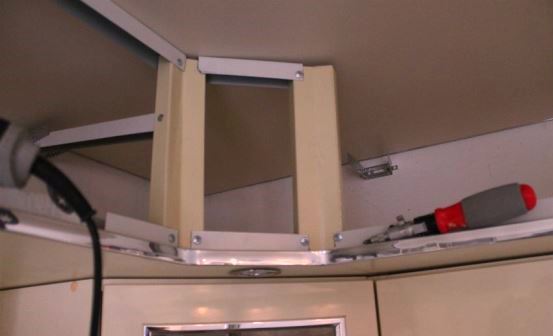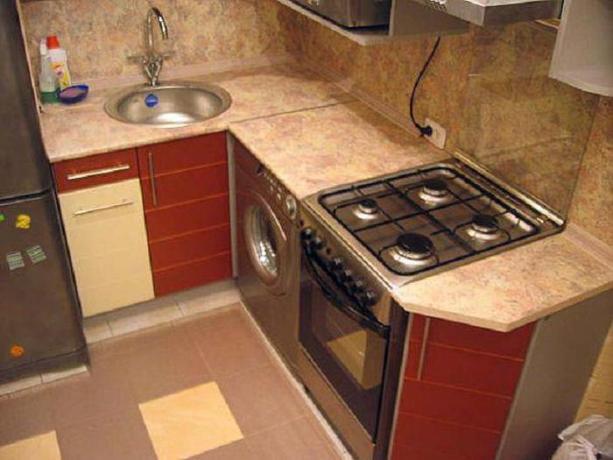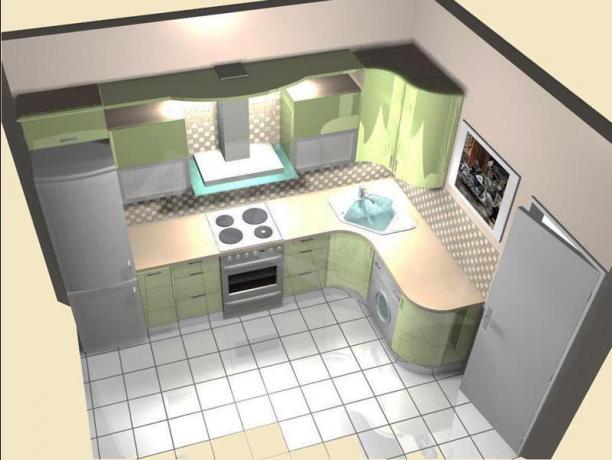Content
- 1 Dimensions of boxes
-
2 Review of 3 articles
- 2.1 Plastic
- 2.2 Metal
- 2.3 Drywall
- 3 We mount the duct box
- 4 Finally
Almost any hood needs to mask the internal elements, which in most cases have a very unsightly appearance. For these purposes, a box for a kitchen hood is used, which can perform masking and decorative functions. For more details about the features of the dimensions of these structures, the materials used for their manufacture and the installation of the box with your own hands, read our material.

The box in the kitchen for the hood can not only cover the device itself, but also mask the air duct
Dimensions of boxes
I would like to note right away that it is difficult to determine exactly what is considered a box. Some call it the decorative plate that covers the unit, some call it the ventilation ducts that cover the corrugation. Let's analyze both constructions.
The range of hoods is as extensive as the appliances themselves. They can differ not only in designs and sizes, but also in the materials from which they are made. When choosing a camouflage box for the device, the first thing you should pay attention to is
its dimensions. Let's consider this moment in more detail.
The width of the box, like the hood, must be at least the width of the hob
- Width. Most often, hoods have a width of about half a meter and, accordingly, the width of the box should be approximately the same value. If the width of the device differs from the specified standard, then the size of the coating should be adjusted for a single instance.
- Depth. This indicator should be at least 30 cm - it is this value that is the minimum acceptable for accommodating corrugations and other internal elements of the unit. However, if you want to use the structure as a full-fledged hanging cabinet, then its depth may matter more.
- Height. This indicator determines the previously drawn up kitchen design with an exhaust duct - the level of the adjacent interior elements is taken as a basis. It would hardly be appropriate if the design, the purpose of which is to mask flaws, will stand out from the general setting.

The height at which the structure can be fixed ranges from 65 to 85 cm
In addition to visual perception, technical parameters of the structure placement should be taken into account - the height of the hood should not be determined solely by aesthetic considerations. The unit must be no higher than 85 cm and no lower than 65 cm above the surface of the stove. This is necessary for its correct operation, and will also avoid inconveniences that may arise during the cooking process.

The duct box can be used not only for masking, but also for practical purposes
Review of 3 articles
The hood box for the kitchen can be made of metal, drywall, plastic, etc. When choosing material must be based not only on its decorative qualities, but also on the advantages and disadvantages. Let's consider the most popular options.
Plastic
Plastic structures are divided into square, round and rectangular. The choice of shape will depend largely on the shape of the vent. The easiest way is to disguise flat boxes that can easily hide in the corner of a room or behind a headset. However, they are only suitable for low power devices.

The shape of plastic models can be rectangular, round or square
Benefits: A duct for a kitchen hood made of plastic, as well as an air duct, can simultaneously perform decorative and masking functions. Easy to process, if necessary, it can be painted over to match the color of the walls or headset. The low conductivity of the plastic reduces the noise level from the switched on device. Hygienic and durable, resistant to various stains and easy to clean.
disadvantages: Over time, it may fade in the sun or white or gray spots may form on the surface. Despite the strength of the material, it is still subject to mechanical stress.

The plastic is strong enough and easy to clean
Metal
The camouflage structure for the hood can be made of steel, stainless steel or aluminum, covered with a protective layer of paint or polymers. Ideal for loft, techno or hi-tech style.

A metal structure (example in the photo) can perfectly fit into the interior of a loft, hi-tech or techno
Benefits: The box in the kitchen for the hood is highly durable and has a long service life. Stainless steel structures are not subject to corrosion even after strong mechanical stress.
disadvantages: Due to its weight, such a material will need additional reliable fasteners. The material amplifies the noise from the operating device, fingerprints, water drops or grease are also clearly visible on it.

For metal structures, you will need to use additional fasteners
Drywall
Perhaps the most budgetary option of all these. It allows you to easily mask almost all elements of the hood that do not fit into the interior.

Working with drywall is easy even without proper experience.
Benefits: In addition to the fact that their price is affordable for anyone, drywall structures can be given any shape and painted in any color. Easy to install with your own hands, which allows you to save not only on materials, but also on labor.
disadvantages: Moisture-resistant, cheap drywall is not the material to be used in the kitchen. You need to choose only moisture resistant options.

A plasterboard exhaust box for the kitchen will not work, but additional lighting can be built into it
We mount the duct box
The ventilation ducts for the cooker hood perform an important function - they mask the unit, allowing it to blend in with the interior. But also do not forget about the structures for the corrugation, which can greatly spoil the overall look of the kitchen. Read about how to make it yourself in this section.
Illustration |
Instructions for action |
 |
Install the guides. First, you need to install guide profiles, which will become the basis of the future box. To get a perfectly even result, use a building level. |
 |
Secure the spacers. They are necessary so that the entire structure does not collapse during the installation of the gypsum plasterboard. |
 |
Attach drywall. Screw the fitted drywall sheets to the profiles. |
 |
Disguise the joints. Apply a grout to them, then putty the surface and paint if desired. |
Finally
We told you what to look for when choosing a hood for a kitchen hood and shared information about the materials from which it can be made. You also learned how to assemble a corrugation box with your own hands. You can find even more useful information on the proposed video.


